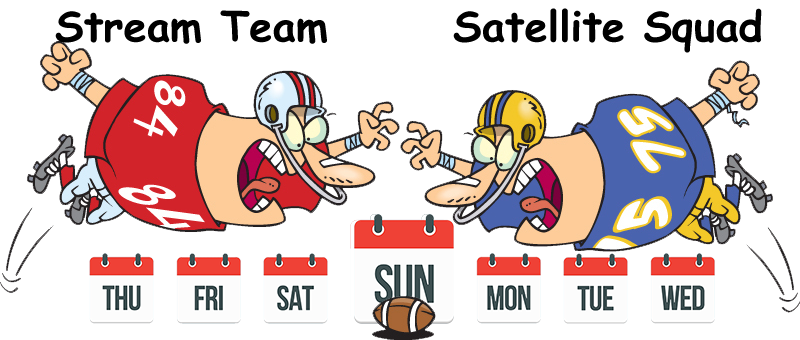
The holidays always remind me of great food, conversation, and watching football with relatives after the meal is over and we’ve run out of things to say. As a British transplant in America, I really don’t understand the game. I get the basics: get the ball from your end to your opponent’s end and score a goal – er, touchdown. But beyond that, I get a little lost on the whole thing. As far as I can see, you are rarely allowed to kick the ball, unlike the original football still played in the rest of the world, players come on and off the field depending on the play and the game seems to be comprised of a million ten-second plays possibly designed more with advertising in mind than a fluid viewing experience. But more than anything, I’m confused about how to watch the games on TV.
I know, it should be simple and, to be honest, if I applied any real effort in this direction, I would surely have nailed it by now. But come on. Seriously, it’s not that simple. If I understand it correctly, watching my local team is easy: good old broadcast TV has me covered (assuming I haven’t cut the cord, of course). The real challenge seems to be if I want to watch a team other than my local one. Amazon seems to have the scoop on Thursday games and, until now, DirecTV had the rights to NFL Sunday Ticket. In other words, Thursday meant streaming TV but, for Sunday viewing, I needed to stick a satellite dish on my house and then find an additional $300 for the channel? See? A confusing sport. So, the players rarely kick the ball, and the viewers need a satellite dish to watch all the action.
Times may be getting a little simpler as YouTube has just bought the rights to the Sunday games. NFL Sunday Ticket will be leaving DirecTV and moving to the streaming world.
I must confess, I’m very torn on this. On the one hand, separating the game from a ridiculous hardware requirement is a good thing. It means that many more consumers could subscribe to the Sunday action (it is estimated that NFL Sunday Ticket currently has about two million subscribers). If you have a decent internet connection you can now subscribe to the action, although you may have to subscribe to YouTube TV as a base requirement and then pay an additional fee for the Sunday Ticket. Streamers of the world (or at least the U.S.) celebrate: if you have the connection, the money, and the desire you can now watch football on Thursdays and Sundays from anywhere in the country.
But what if you don’t have a decent internet connection? Fifty percent of U.S. households receive less than broadband speed in their homes, and many of these have between zero and 10 Mbps. Good luck streaming all the action on that connection. Can you imagine getting the buffering wheel just when the action gets fast and furious? Don’t worry, I’m sure it’ll stop buffering right after the play has finished so you can watch the players preparing for the next strategic move. Stop motion football: cool.
But while the move from satellite to streaming further exacerbates the digital divide, it has to be acknowledged that the previous DirecTV option was also incredibly limiting. Tying TV access to any hardware – dish or internet – feels like a poor customer choice. Indeed, DirecTV did offer a streaming-only version of the Sunday Ticket, but only to homes that could not get satellite coverage (e.g., apartment dwellers, homes with no clear line of sight, and so on). It was very clear that the main purpose of DirecTV’s Sunday Ticket was to drive consumers to buy a satellite dish. That is a strategy that should have died at least 10 years ago, frankly. But the move from satellite to streaming-only feels like yet another blow to the consumers in rural parts of America who cannot get high-speed internet. It is no coincidence that satellite TV adoption is far greater in rural America, with 23% of rural homes subscribing to satellite for TV access, according to the NPD Connected Intelligence Broadband Consumer Report from November 2022. It’s often their only TV option.
So, here’s a suggestion for the NFL: create a divided solution and offer both a satellite and a streaming solution. They both address different audiences and bridge the digital divide, rather than the current streaming-only focus that widens the divide. Of course, it’s probably too late. The YouTube deal seems to be done. But perhaps YouTube could also consider ways to broaden the audience (and its revenue model) by some strategic reselling into markets that have limited internet options. After all, even I, someone who has almost no understanding of the game, still wants to watch occasionally, to get through those awkward holidays.


